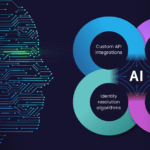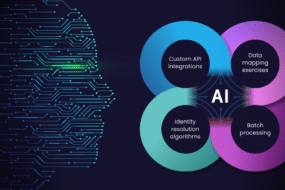
Imagine, a scientist asks an AI system to analyze millions of molecules overnight—by morning, she has a shortlist of promising drug candidates. At a clinic, a doctor consults an AI tool that looks at a patient's unique genetic blueprint to recommend the perfect treatment. In a manufacturing plant, AI predicts equipment failures before they happen, preventing costly delays. And as a new medicine is developed, an AI assistant compiles thousands of pages of trial data in hours instead of weeks.
This isn't science fiction; This is happening right now.
Welcome to an age where artificial intelligence is reshaping how we discover, develop and deliver medicines. In this post, we will break down the five biggest AI trends in pharma in simple, conversational language with real-world examples. Whether you are a pharma executive, IT specialist, student, or business professional with no background in either field, you'll walk away understanding how AI is revolutionizing medicine.
How AI works in Pharma: The basics
Before diving into trends, let's chat about what AI actually does in pharmaceuticals:
Think of AI as a super-powered pattern detector. Where traditional computers follow strict rules, AI systems learn from data—millions or billions of examples—to find connections humans might miss.
In the world of medicine, this means AI can look at successful drugs to suggest new ones, notice which patients respond better to specific treatments, predict manufacturing issues before they happen, and plow through thousands of research papers overnight to find relevant information. Simply put: Where humans get overwhelmed by data, AI thrives, making it perfect for the complex world of medicine.
1. AI-driven transformation: Rethinking how Medicines are made
Not long ago, finding new medicines meant scientists testing thousands of compounds one by one in lab dishes—a process that could take years with lots of dead ends. Today, pharma companies are using AI to work smarter and faster.
The numbers tell the story: By 2025, pharmaceutical AI spending is expected to reach around $3 billion. Over 100 partnerships between pharma and AI startups have formed in recent years (up from just 10 in 2015). Almost every major pharmaceutical company now has AI programs.
Why it matters: Consider how AI is changing drug discovery:
- Traditional approach: Scientists manually test thousands of compounds in lab dishes over the years.
- AI approach: Computer models predict which molecules will likely work as medicines in weeks.
- Result: What once took five years might now take six months.
Real-world examples anyone can understand:
- Pfizer + Tempus: Pfizer worked with Tempus, who organizes and analyzes medical data, to find patterns that helped speed up COVID-19 drug development. It's like having a super-smart assistant who can instantly spot the needle in a haystack when you would normally search strand by strand.
- AstraZeneca + BenevolentAI: AstraZeneca teamed up with BenevolentAI to find new kidney disease treatments that human researchers hadn't noticed. Imagine having a research partner who has read and remembered every medical paper ever written.
- Sanofi + AI partners: Sanofi used AI to match patients to clinical trials in minutes instead of months. Picture going from manually reviewing 10,000 patient files to having a computer instantly find the perfect matches.
Beyond finding new drugs: AI is touching every part of the medicine-making process:
- AI helps find the right patients for testing new treatments.
- AI chatbots answer patient questions about medications any time of day.
- AI ensures medicines are made consistently and safely.
For patients, this means new treatments arrive years sooner. For companies, it means staying competitive in a rapidly changing industry.
2. Personalized Medicine: Treatment as unique as you are
If you've ever wondered why a drug works for some people but not others, you've touched on something big in modern medicine. We're moving away from the "one-size-fits-all" approach to treatments that are tailored to you as an individual.
The science behind this involves looking at your DNA—essentially the instruction manual inside your cells that makes you unique. Modern technology can now "read" this manual quickly and affordably, generating enormous amounts of data that AI can analyze to make treatment more precise.
How AI makes treatment personal:
When AI studies information from thousands of patients, it starts to recognize patterns. It might discover that people with certain genetic features respond best to one medication while others need something different. By looking at your specific makeup, AI can help predict which medicine will work best for you and at what dose.
Real-world examples:
- Tempus: This company builds AI that looks at cancer patients' genetic information and treatment history. It's like having a doctor who has treated millions of patients with your exact type of cancer. Tempus might tell your doctor: "Based on this patient's specific tumor characteristics, Drug X has an 80% success rate while Drug Y only has 30%."
- Moderna: During COVID-19, Moderna used AI to design its vaccine by analyzing the virus's genetic code and creating instructions (mRNA) that would teach our immune systems to recognize and fight it. Think of it as creating a custom training manual for your immune cells.
- Novartis + Microsoft: Their partnership uses AI to analyze eye scans and genetic information to customize treatments for an eye disease called macular degeneration. It's like having custom glasses made exactly for your vision instead of generic ones.
What does this mean for you: Instead of the trial-and-error approach ("Try this medicine and come back in a month"), doctors will increasingly say, "Based on your specific profile, this particular medicine at this specific dose will work best for you."
This is already happening in cancer treatment and will soon expand to many more conditions.
3. Advanced therapies: AI supercharges biological breakthroughs
The medicine cabinet of the future looks very different from the simple pills we're used to. We're now developing treatments made from living cells (biologics), therapies that fix faulty genes, and even approaches that take your own cells, reprogram them to fight disease, and put them back in your body.
These advanced therapies are incredibly complex to develop—think of building a spaceship versus a bicycle. This is where AI becomes essential:
How AI helps, in simple terms:
- Designing biological medicines: Biologics have complex 3D shapes that determine how they work. AI can predict these shapes and design new ones—like having an architect who can instantly design millions of building blueprints and tell you which ones will stand.
- Making gene editing safer: When scientists try to fix faulty genes, they need to be incredibly precise. AI can predict potential off-target effects—like having a safety inspector who can spot problems before they happen.
- Improving manufacturing: Making biological medicines is more like brewing beer than manufacturing pills—small changes can affect the whole batch. AI monitors the process to ensure consistency.
Real examples anyone can understand:
- DeepMind's AlphaFold: This AI system learned to predict the 3D shape of proteins with amazing accuracy. Scientists have struggled with this problem for decades! It's like suddenly having a map when you've been navigating by guesswork.
- Moderna's COVID-19 vaccine: Moderna used AI to design its vaccine quickly after receiving the virus's genetic sequence. Without AI, this would have taken a long time.
- CRISPR and sickle cell disease: In 2023, the first CRISPR gene therapy was approved for sickle cell disease. AI helped ensure the gene edits were precise and safe—like having a GPS for molecular scissors to make sure they cut exactly where intended.
- Dyno Therapeutics: This company uses AI to design better delivery vehicles for gene therapy. It's like upgrading from a paper airplane to a targeted drone to deliver genetic medicine to exactly the right cells.
These breakthroughs mean that diseases we once thought untreatable—certain genetic disorders, aggressive cancers, and degenerative conditions—may soon have effective treatments or even cures.
4. Global market access: AI as a strategic compass
Getting medicines to patients worldwide isn't just about science; it's about logistics, market understanding, and strategic planning. Companies must be efficient, strategic, and globally aware. AI helps navigate these challenges in several practical ways:
Supply chain superpowers:
- Smarter forecasting: Traditional approaches might predict general demand, but AI can get specific—like knowing you'll need more flu vaccines in certain regions because of weather patterns and travel data.
- Temperature protection: Many modern medicines must stay cold. AI systems now track these medicines in transit and alert companies before problems occur—like having a digital guardian watching your medicine 24/7.
- Preventing shortages: Large number of pharma companies use AI to prevent running out of important medicines. Instead of reacting after a shortage happens, AI predicts potential problems months in advance.
Real-world example: During COVID-19, Pfizer used AI to manage its vaccine supply chain, predicting demand across countries and optimizing shipping routes for temperature-sensitive vaccines. This helped deliver billions of doses globally with minimal waste.
Understanding global markets:
AI helps companies understand health needs in different countries by analyzing local health records, social media, and demographic data.
For example, an AI system might spot that diabetes treatments in India need different approaches based on population-specific factors that wouldn't be apparent without analyzing millions of patient records.
Competitive strategies anyone can understand:
- Finding new uses for existing medicines: AI reviews scientific papers to discover that an existing heart medication might also treat a rare lung condition. It's like finding out your screwdriver also works perfectly as a pry bar—getting more value from tools you already have.
- Smart manufacturing: Large number of biopharma companies are investing in AI-powered manufacturing. Imagine a factory where machines predict their own maintenance needs and automatically adjust production to maximize quality.
Company examples:
- Amgen: Used AI to double its clinical trial enrollment speed—like upgrading from manual matchmaking to a dating app that instantly finds compatible matches.
- Takeda: This Japanese pharma giant uses AI to determine if a doctor prefers educational emails, in-person visits, or video content—delivering information the way each doctor prefers.
- Recursion + Exscientia merger: These two AI-driven drug discovery companies joined forces in 2024, combining Recursion's automated labs that test thousands of compounds daily with Exscientia's AI that designs new drugs. Together, they've partnered with companies like Bayer, Roche, and Sanofi to accelerate drug discovery.
This AI-powered approach means medicines reach patients faster, with fewer shortages and at potentially lower costs.
5. Regulatory navigation: AI as a compliance partner
Before a new medicine reaches patients, it needs approval from regulatory agencies like the FDA and coverage from insurance companies. These processes have traditionally been slow and paperwork-heavy, but AI is changing that:
Making sense of mountains of paperwork:
- A single new drug application to the FDA can exceed 100,000 pages—equivalent to about 400 novels.
- AI can read all those pages overnight, flag inconsistencies, and suggest improvements.
- Pfizer has used AI to analyze regulatory submissions and found it could reduce document preparation time by 30%—turning a 6-month process into 4 months.
Safety monitoring made simple:
- After a medicine reaches the market, companies must track all reported side effects.
- Traditionally, teams of people read thousands of reports, looking for patterns.
- AI can scan millions of reports, social media posts, and even doctor's notes to identify safety concerns faster.
- The FDA itself now uses AI to monitor for medication safety signals—like having thousands of safety inspectors working 24/7.
Proving medicine’s value:
- Getting FDA approval isn't enough—insurance companies need to be convinced a drug is worth covering.
- AI analyzes real-world patient outcomes to show how a medicine performs outside clinical trials.
- For example, an AI system might analyze hospital records to prove that patients taking a new diabetes drug have 40% fewer emergency room visits, making a clear financial case for coverage.
Reimagining clinical trials:
- A company called Unlearn.AI works with regulators on trials where AI creates "digital twins" of patients. If the AI can accurately predict how a patient would respond without treatment, fewer people need to receive placebo (non-active treatment).
- This means more patients get the actual treatment, trials require fewer participants, and results come faster.
For patients, these AI applications mean life-saving treatments can reach them months or years sooner. For companies, it means navigating regulations more efficiently and getting approved treatments to market faster.
What's next: Breakthrough areas to watch
Looking ahead, several AI-powered opportunities will reshape pharma in the coming years. Here are the most exciting ones with concrete examples:
- AI creating brand new Medicines: AI systems can now create entirely new drug molecules—like having a creative scientist that works millions of times faster than humans. Insilico Medicine used this approach to create a completely novel treatment for lung scarring (fibrosis) that went from concept to human testing in under 30 months instead of the usual 5+ years. This matters because diseases that have resisted treatment for decades could finally have effective medicines as AI explores possibilities humans would never think to try.
- Digital twins for testing treatments: Imagine having a virtual copy of yourself—reflecting your genes, medical history, and body responses—that doctors could use to test treatments before giving them to you. Unlearn.AI has created these digital twins for Alzheimer's trials. When a new patient joins a trial, the AI predicts how their disease would progress without treatment. In the future, if you have a condition like diabetes, your doctor might use your digital twin to simulate how you'd respond to different medications before prescribing the one that works best for your unique body.
- Smart factories that think ahead: Next-generation manufacturing facilities use AI to oversee the entire production process, making adjustments in real-time. Sanofi has invested $2 billion in these "smart factories" where AI monitors biological drug production—in one facility, AI detected subtle changes in cell growth patterns and automatically adjusted nutrients, increasing yield by 15%. These smart factories can produce medicines more consistently, with fewer failed batches and at lower cost, potentially making expensive treatments more affordable.
- Finding powerful medicine combinations: AI can discover unexpected combinations of existing medicines that work better together. UK-based BenevolentAI used its platform to identify that baricitinib (an arthritis drug) could help treat COVID-19 when combined with other treatments—a discovery made in days rather than months. For hard-to-treat infections, AI might discover that combining three existing antibiotics in a specific way overcomes resistance—giving new life to our medical arsenal.
- AI health companions: Imagine smartphone apps with AI that helps you manage your treatment, answers questions, and alerts your doctor when needed. Livongo (now part of Teladoc) uses AI to help patients with diabetes manage their condition, analyzing blood sugar readings and providing personalized coaching—helping reduce dangerous low blood sugar events by 63%. Soon, your prescription might come with a companion app. For example, a depression medication might include an AI app that checks in daily, monitors symptoms, and alerts a doctor if you show warning signs.
Getting started: Action steps for every role
No matter your position, here are concrete ways to begin using AI in pharma, with specific examples for each role:
- For R&D scientists: Start using AI tools like Atomwise or DeepChem to predict properties of compounds you're researching. Researchers at Merck used this approach to predict which compounds would be easily absorbed by the body, reducing testing time by 40%. Today's step: Pick one repetitive analysis task you do regularly and explore tools that could automate it.
- For clinical teams: Use AI for finding the right patients for your trials—typically your biggest bottleneck. Antidote's AI platform helped a respiratory disease trial identify suitable patients three times faster by scanning health records and matching them to trial criteria. Start here: For your next trial, run your traditional recruitment alongside an AI approach and compare results.
- For operations managers: Implement AI-powered demand forecasting for your products. Johnson & Johnson uses AI to predict demand for specific products in different regions, reducing inventory costs by 15% while maintaining supply. Begin with: Choose one product line with unpredictable demand patterns and test an AI forecasting tool from providers like Blue Yonder or o9 Solutions.
- For IT teams: Start by assessing how ready your company's data is for AI applications. Novartis created a centralized data platform called "Data42" that connected previously siloed information, enabling over 150 AI projects across the company. First action: Identify your most valuable but underutilized data sources and plan how to make them accessible for AI applications.
- For marketing teams: Use AI to understand healthcare providers' preferences and tailor your approach. A major pharma company used AI to analyze doctor engagement data and found that certain specialists preferred brief video content early in the morning—this simple insight increased engagement by 30%. Quick start: Use an AI tool to analyze your current marketing data and identify which messages resonate best with different provider segments.
- For regulatory professionals: Try AI tools for document review and preparation. Merck used natural language processing to review regulatory submissions, reducing review time by 25% and catching inconsistencies human reviewers missed. Easy beginning: Use AI to compare a current submission document against previously approved ones to ensure consistency.
- For everyone: Start with a small pilot project addressing a specific pain point. Choose something concrete that could show results in 3-6 months. Partner with an AI vendor or internal data science team who can guide you. Remember: The goal isn't perfection but learning and improvement.
Conclusion: The human side of a technological revolution
The impact of AI in pharma isn't hype—it's transforming how we discover, develop, and deliver medicines to patients. From designing new therapies to ensuring they reach the right patients at the right time; AI is accelerating progress across the board.
Yet amidst all this technology, the human element remains crucial. AI is a powerful tool, but it's the people in pharma who decide how to use it for good. AI can process data at superhuman speed, but it doesn't replace human intuition, ethics, and empathy.
This means collaboration becomes more important than ever. When data scientists work alongside biologists, when engineers visit manufacturing floors, when marketers listen to patient experiences, these interactions ensure AI solutions address real-world needs.
The next few years will bring AI deeper into every pharma company's strategy. Medicine discovery will include AI-generated candidates. Clinical trials will adapt on the fly using AI insights. Supply chains will become smarter and more responsive. And patients might have AI companions supporting their treatment journeys.
But whatever the timeline, the guiding principle should be to keep it human-centric. By making AI practical and accessible, we turn it from a buzzword into a toolset that improves lives.
In the end, the story of AI in pharma is about improving our collective ability to care for one another. It's about researchers reaching breakthroughs faster, doctors making more informed decisions, and patients living healthier lives.
AI is simply the latest, perhaps one of the greatest, innovations fueling the next chapter in medicine's story. The pill bottles on the shelf and the digital tools in our pockets are converging. By harnessing both, we stand on the threshold of a healthier future—and that's something worth getting excited about.
Search
Trending Posts
GPT-5: The Reality Behind the Hype
- August 19, 2025
- 11 min read
Trump’s Saudi Tour: Oil Barrels to AI
- June 6, 2025
- 12 min read
Marketing’s Gen AI Leap
- May 20, 2025
- 18 min read
Gen AI: From Customer Support to Delight
- May 18, 2025
- 16 min read
AI-First Companies: From Buzzword to Real Change
- May 10, 2025
- 12 min read










